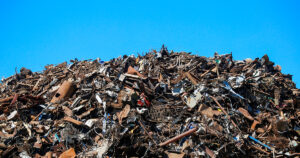
In 2024, ferrous scrap enterprises sharply increased exports of strategic raw materials for steelmaking companies by 60.6% compared to 2023, to 293.1 thousand tons (in 2023, exports amounted to 182.5 thousand tons, in 2022 – 53.6 thousand tons).
According to the Ukrainian Association of Secondary Metals (UAVtormet), scrap collectors increased scrap supplies to Ukrainian steelmakers by 29.8% year-on-year last year to 1.343 million tons.
The technological reserves of ferrous scrap at the enterprises were estimated at 40-50 thousand tons at the end of the year. At the same time, the estimated technological needs of metallurgists for this raw material, according to the Association, are fully met, with an excess of 3.5-5.2%.
Last year, the volume of ferrous scrap procurement increased by 37% to 1.749 million tons. According to UAVtormet, this trend was driven by an increase in steel production at metallurgical and foundry enterprises with a corresponding increase in scrap consumption, as well as the export capabilities of Ukrainian procurement companies during the reporting year.
Scrap imports amounted to 1.2 thousand tons in 2024 and 1.1 thousand tons in 2023.
It is also stated that steel production last year amounted to 7.575 million tons, which is 21.6% more than the previous year.
According to the forecast, Ukraine will produce 6.5-6.8 million tons of steel in 2025 (6.228 million tons were produced in 2023, 6.263 million tons in 2022), and will procure 1.450-1.650 million tons of scrap metal (1 million 277.3 thousand tons in 2023, 996.7 thousand tons in 2022). Steelmakers are also expected to consume 1.1-1.2 million tons of scrap (1 million 34.7 thousand tons in 2023 and 895.7 thousand tons in 2022), export 300-350 thousand tons of scrap (182.5 thousand tons in 2023 and 53.6 thousand tons in 2022), increasing the export of strategic raw materials for steelmakers. Scrap imports are expected to reach 1.5-3 thousand tons.
Earlier, Ukrmetallurgprom President Oleksandr Kalenkov stated in a column on theInterfax-Ukraine website that scrap metal is exported through the European Union, which has a preferential export duty of EUR3 per ton, and from there the raw materials are redirected to real customers. He pointed out that exporting raw materials directly to customers would cost EUR180 in export duties, and the Ukrainian budget has already lost UAH 350 million.
The head of Ukrmetallurgprom called for a temporary ban on the export of ferrous scrap to provide steelmakers with strategically important raw materials during the war. He also clarified that a ton of scrap metal processed into steel brings in ten times the amount of export duties to the EU – up to $300 per ton.
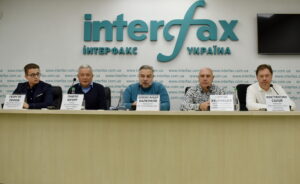
The National Association of Extractive Industries of Ukraine, Ukrmetallurgprom, the Ukrainian Association of Ferroalloy Producers (UkrFA), the All-Ukrainian Union of Construction Materials Producers, and Ukrcement ask President Volodymyr Zelenskyy to instruct the ministries to promptly resume booking employees through the Diia portal.
“We understand and share the president’s desire to put things in order with the booking of workers. However, against the backdrop of questionable decisions by local authorities, the relevant ministries have also completely suspended the booking process,” the letter, which was seen by Interfax-Ukraine, reads.
Its authors recognize that the current reservation procedure is not perfect and contains certain flaws that allow companies that are not in fact critical enterprises to be granted the status of critical enterprises. However, in the associations’ opinion, it is primarily a matter of the possibility of obtaining such a status by decision of local state (military) administrations.
At the same time, the letter states, following a meeting held in early October and the Cabinet of Ministers’ decision to audit the decisions made on reservations, some ministries also suspended the reservation process, although it was declared that this decision did not apply to them. According to the associations, these ministries have completely suspended the processes of confirming the status of critical enterprises and booking employees for truly important enterprises that have already received this status from the relevant ministry. In addition, the possibility of booking employees through the Diia portal has been suspended until November 15.
“We are confident that your instructions were aimed at identifying risks and shortcomings for their further elimination, but were not intended to stop all processes of booking personnel for truly critical enterprises, which could completely stop the economy and lead to catastrophic consequences,” the letter says.
As reported, after the government’s protocol decision of October 8 to audit decisions on recognizing enterprises as critical to the economy, the booking process was effectively paralyzed, which caused protests from many business associations.
On October 22, the government introduced the possibility of repeated audits of companies’ compliance with the criteria of critical importance “if necessary.” The document stipulates that these inspections are to be conducted by the same authorities that initially granted the companies the status of critical. The result of such an audit may be that the company does not meet the criteria of a critical enterprise and that its status is revoked. The authorities must provide a copy of the decision based on the results of the re-inspection to the Ministry of Economy, the Ministry of Defense (the SBU, the Foreign Intelligence Service, the intelligence agency of the Ministry of Defense) and the Ministry of Digital Transformation within one day.
employee, reservations, UKRCEMENT, UKRMETALLURGPROM, ZELENSKY, УкрФА
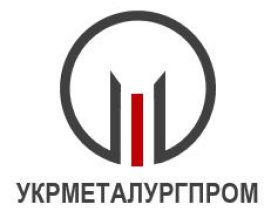
In January-September this year, Ukrainian enterprises reduced their consumption of rolled steel by 6.92% year-on-year to 2.425 million tons.
According to a press release from Ukrmetallurgprom, 927 thousand tons, or 38.23% of the domestic rolled metal consumption market, were imported during this period.
According to Ukrmetallurgprom, in January-September 2014, steel companies produced 4.821 million tons of rolled metal products (122.7% compared to the same period in 2023). According to the State Customs Service of Ukraine, about 3.323 million tons, or 68.9%, were exported. In January-September 2013, the share of exports amounted to 54.5% (2.142 million tons against a total rolled steel production of 3.929 million tons).
The share of semi-finished products in export deliveries in January-September 2024 amounted to 46.98%, which is almost the same as in January-September 2023 (45.10%). The share of flat products in export deliveries in 9M2024 is slightly higher than in January-September 2023 (39.03% and 36.65%, respectively). The share of long products is significantly lower than in January-September 2023 (13.99% in 2024 vs. 18.25% in 2023).
“In the first nine months of 2024, the domestic market capacity amounted to 2.425 million tons of rolled steel, of which 927 thousand tons, or 38.23%, were imported. In January-September 2023, the domestic market capacity amounted to 2 million 605.4 thousand tons, of which 818.4 thousand tons, or 31.41%, were imported. Thus, in the first nine months of 2024, there was a decrease in the domestic market capacity by 6.92% compared to the first nine months of 2023, with a simultaneous increase in the share of the import component by 6.82%,” the press release states.
The structure of imports in January-September 2024 is still characterized by a significant dominance of flat products over long products (79.36% and 19.19%, respectively). In January-September 2023, the dominance of flat products over long products was also significant (80.78% and 18.29%, respectively).
According to the State Customs Service, the main export markets for Ukrainian rolled steel products in January-September 2024 were the European Union (69.6%), Africa (11.7%) and the rest of Europe (7.6%).
Other European countries ranked first among metallurgical importers in the period under review (49.6%), followed by the EU-27 (28.2%), and Asia (20.6%).
As reported, Ukraine’s rolled steel market increased 2.19 times in 2023 compared to 2022, to 3 million 505.6 thousand tons. The company imported 1 million 118.6 thousand tons, or 31.91% of the domestic market for these products.
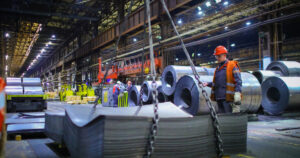
Ukrainian metallurgical enterprises in January-May this year increased production of total rolled products by 29.5% year-on-year to 2.568 million tons from 1.982 million tons, according to preliminary data.
According to Ukrmetallurgprom on Friday evening, steel production increased by 31.2% over the period to January-May 2023, to 3.139 million tons from 2.392 million tons.
Pig iron production increased by 20.8% to 2.839 million tons from 2.350 million tons.
As reported earlier, in January-2024, Ukraine increased production of total rolled products by 75.9% year-on-year to 453 thousand tons from 257 thousand tons, steel by 91.6% to 544 thousand tons from 284 thousand tons, and pig iron by 44.5% to 555 thousand tons from 384 thousand tons.
In January-February 2024, rolled steel output increased by 52.5% year-on-year to 900 thousand tons from 590 thousand tons, steel output by 52% to 1.076 million tons from 708 thousand tons, and pig iron output by 42.5% to 1.050 million tons from 737 thousand tons.
In the first quarter of 2024, the company increased production of total rolled products by 35.5% to 1.389 million tons, steel by 36.6% to 1.687 million tons, and pig iron by 32.1% to 1.589 million tons.
In January-April 2024, production of total rolled products increased by 30.5% to 1.973 million tons from 1.512 million tons, steel by 32.8% to 2.402 million tons from 1.809 million tons, and pig iron by 25.1% to 2.186 million tons from 1.747 million tons.
In 2023, Ukraine increased production of total rolled products by 0.4% compared to 2022 to 5.372 million tons, but reduced steel production by 0.6% to 6.228 million tons and pig iron by 6.1% to 6.003 million tons.
In 2022, Ukraine reduced production of total rolled products by 72% compared to 2021, to 5.350 million tons, steel by 70.7% to 6.263 million tons, and pig iron by 69.8% to 6.391 million tons.
In 2021, the company produced 21.165 million tons of pig iron (103.6% compared to 2020), 21.366 million tons of steel (103.6%), and 19.079 million tons of rolled products (103.5%).
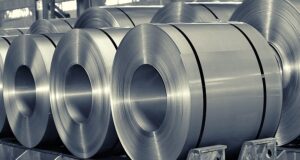
Ukrainian metallurgical enterprises increased production of rolled steel by 30.5% year-on-year to 1.973 million tons from 1.512 million tons in January-April this year, according to preliminary data.
According to Ukrmetallurgprom on Thursday, steel production increased by 32.8% y-o-y to 2.402 million tons from 1.809 million tons in January-April 2023.
Pig iron production increased by 25.1% to 2.186 million tons from 1.747 million tons.
As reported earlier, in January 2014, Ukraine increased production of total rolled products by 75.9% year-on-year to 453 thousand tons from 257 thousand tons, steel by 91.6% to 544 thousand tons from 284 thousand tons, and pig iron by 44.5% to 555 thousand tons from 384 thousand tons.
In 2M2024, rolled products output increased by 52.5% y-o-y to 900 thousand tons from 590 thousand tons, steel output by 52% to 1.076 million tons from 708 thousand tons, and pig iron output by 42.5% to 1.050 million tons from 737 thousand tons.
In 1Q2024, the company increased production of total rolled products by 35.5% to 1.389 million tons, steel by 36.6% to 1.687 million tons, and pig iron by 32.1% to 1.589 million tons.
In 2023, Ukraine increased its production of total rolled products by 0.4% compared to 2022, to 5.372 million tons, but reduced steel production by 0.6% to 6.228 million tons and pig iron by 6.1% to 6.003 million tons.
In 2022, Ukraine reduced production of total rolled products by 72% compared to 2021, to 5.350 million tons, steel by 70.7% to 6.263 million tons, and pig iron by 69.8% to 6.391 million tons.
In 2021, the company produced 21.165 million tons of pig iron (103.6% compared to 2020), 21.366 million tons of steel (103.6%), and 19.079 million tons of rolled products (103.5%).

The association of enterprises “Ukrmetallurgprom” considers it necessary to temporarily ban the export of scrap ferrous metals to provide metallurgical enterprises with strategically important raw materials in the conditions of the ongoing war.
“If scrap metal will remain in the country – more than 500 thousand people will have a job, and the country will have millions of foreign exchange earnings from the export of steel. At the same time, the military also benefits – because metallurgists help the fighters a lot, buying for them equipment and cars, and even producing body armor. Nobody benefits from the export of scrap metal. So now the authorities should be proactive and temporarily ban exports until the situation stabilizes and stops threatening national economic security,” wrote Ukrmetallurgprom President Oleksandr Kalenkov in his column on the Interfax-Ukraine website.
According to him, since the beginning of the war Ukraine’s mining and metallurgical complex has been experiencing the worst crisis since independence. A large part of the enterprises have been seized or destroyed by the occupiers, while others are trying to work under constant shelling and partial loss of capacity. The blockade of sea ports has led to the fact that the geography of customers has almost halved, and with it the volume of supply of products.
Nevertheless, enterprises are trying to hold on and even increase production, because they realize the level of responsibility entrusted to them. More than half a million Ukrainians work in the metallurgical and allied industries, and MMC’s share in Ukraine’s GDP is over 10%.
“But the reality throws up new challenges every time. One of them was the shortage of scrap metal, without which it is impossible to increase the metallurgical production”, – said the head of the association.
He named the reasons for the deficit: the occupation of the eastern regions, where traditionally significant volumes of raw materials have been procured (the volume of this raw materials has decreased by almost 80%). At the same time the export of scrap metal has increased sharply: only in the first two months of 2023 about 25 thousand tons were exported, which is almost 60% more than in November-December 2022.
“Given the growth rate of the export indicator, at the end of the year we may see a figure of 250 or even 300-400 thousand tons of exports – and this is absolutely unacceptable for a market that can barely collect about 1 million tons of scrap metal per year. After all, the industry will require more than a million – even in conditions of incomplete resumption of production,” wrote the president of Ukrmetallurgprom.
“Now the situation with the shortage has worsened and began to lead to temporary, but so far, production stoppages. However, the issue must be resolved. And the volume of production instead of growing, will fall to a minimum. This, in turn, will provoke a spiral of new problems not only for the industry, but also for the economy – because, let me remind you, even in the toughest year of 2021 the MMC enterprises paid to the budgets over 42 billion gon. And this is exactly the funds, for which Ukraine can build up its military potential and win on the battlefield”, stated Kalenkov.
He added that Ukraine, losing money because of the drop in production, does not earn anything from scrap metal export – the raw material is exported via the European Union, where a favorable export duty of EUR3 is applied, and from there it is redirected to the actual customers. To export raw material directly to customers would cost EUR 180 export duties and the Ukrainian budget lost already EUR 350 mln on it. Not surprisingly, the State Bureau of Reconstruction and Development has already taken an interest in the export schemes and has already launched an investigation.
As Mr. Kalenkov explained, 1 ton of scrap metal processed by the president of Ukrmetallurgprom into steel gives 10 times more to the budget than the export duty payable to the EU – about $300 per ton. Therefore, the question whether to export raw materials or leave them in the country for processing, should not be – the benefits are obvious, he summarizes.
As reported in the middle of 2021, Ukrmetallurgprom asked to ban the export of scrap until the end of 2023. With a corresponding request Ukrmetallurgprom appealed to the Prime Minister of Ukraine Denis Shmygal in a letter dated July 8, 2021.
According to the Ukrainian Association of Secondary Metals (UAVtormet), the export of scrap metal in January-February 2023 amounted to 24.8 thousand tons compared to 7.1 thousand tons in January-February 2022 (an increase of 3.5 times).
© 2016-2025, Open4Business. All rights reserved.
All news and diagrams placed on this Web site is made for internal use. Its reproduction or distribution in any form are welcome in case of placing a direct hyperlink to a source. Reproduction or distribution of information which contains Interfax-Ukraine as a source is prohibited without the written permission from the Interfax-Ukraine news agency. Photoes placed on this site are taken from open sources only; rightholder are welcome to make demands to info@open4business.com.ua , in this case we are ready to put your copyright to a photo or replace it.